Regional Divisions Announce 2023 Outstanding Student Papers During their Fall Meetings

The AAG is proud to announce the Fall 2022 recipients of the AAG Council Award for Outstanding Undergraduate and Graduate Student Papers at a Regional Meeting. The AAG Council Award for Outstanding Undergraduate and Graduate Student Papers at a Regional Meeting is designed to encourage student participation at AAG Regional Division conferences and support their attendance at AAG Annual Meetings. One graduate student and one undergraduate student in each AAG Regional Division receives this yearly award based on a paper submitted to their respective regional conference. The awardees receive $1,000 in funding for use towards their registration and travel costs to attend the AAG Annual Meeting. The board members from each region determine student awardees.
The recipients from each region will be presenting their papers in two dedicated paper sessions at the upcoming 2023 AAG Annual Meeting.
Association of Pacific Coast Geographers/Pacific Coast (APCG)
- Olivia Cameron, Graduate Student Paper, Oregon State University; Paper Title – “Social Identity in Agricultural Decision Making”
East Lakes Division of the AAG (ELDAAG)
- Ruijia Hu, Graduate Student Paper, University of Cincinati; Paper Title – “The use of remotely sensed data to model habitat selections of pileated woodpeckers (Dryocopus pileatus) in fragmented landscapes”
- Connor O’Louglin, Undergraduate Student Paper, Northern Michigan University; Paper Title – “Chemical Inhibitor of Methanogenesis: How Does It React in Different Environments?”
Great Plains/Rocky Mountain Division of the AAG (GPRM)
- Naomi Hazarika, Graduate Student Paper, University of Colorado, Boulder; Paper Title – “Urban ‘Re’-development: Geographies of Caste and the Embodied Infrastructural Realities of Slum Redevelopment in Delhi, India”
Mid-Atlantic Division of the AAG (MAD)
- Lauren Gerlowski, Graduate Student Paper, University of Wisconsin, Madison; Paper Title – “A Teaching Assistant’s Reflections & Lessons from Covid-19”
- Xueyuan Eric Gao, Graduate Student Paper, University of Maryland; Paper Title – “Exploration of a Novel Carbon Removal Solution: Lighting Up Tropical Forests at Night”
Middle States Division of the AAG (MSDAAG)
- Maria Morresi, Graduate Student Paper, West Chester University, Paper Title – “Using GIS to Identify Locations for the Development of Urban Ecological Corridors for Birds: A Philadelphia Case Study “
- Carolyn Weinstein, SUNY New Paltz, Undergraduate Student Paper; Paper Title – “Breaking Barriers at Land Grant Institutions: A Historic Geography”
New England – St. Lawrence Valley (NESTVAL)
- Antoine Lachance, Graduate Student Paper, Concordia University; Paper Title – “The history of storms and hurricanes over the past 1000 years in the Gulf of St. Lawrence, as told by coastal ombrotrophic peatbogs on the Magdalen Islands, Québec, Canada”
- Theresa Cocola, Undergraduate Student Paper, Southern Connecticut State University; Paper Title – “Assessing Sustainable Consumption Behavior: A Case Study of Starbucks, Newington, Connecticut”
Southwest Division of the AAG (SWAAG)
- Weiying Lin, Graduate Student Paper, Texas A&M University; Paper Title – “The influence of urban form and sociodemographic factors on street-level greenery play out at multiple scales and vary across space”
- Sarah Pettyjohn, Undergraduate Student Paper, University of North Texas; Paper Title – “How does sediment grain size decrease as rocks are transported within the flowing water of a river?”
- Jacob Hines, Undergraduate Student Paper, Tarlton University; Paper Title – “Examining Red Tide within Florida’s Tampa Bay”
West Lakes Division of the AAG (WLDAAG)
- Lauren Weber, Graduate Student Paper, University of Illinois; Paper Title – “Crisis, carcerality, and the real estate state: Portland, Oregon’s jail-to-shelter conversion”
- Owen Bomba, Undergraduate Paper, DePaul University; Paper Title – “Zombies and Ghosts: The Critique of Modern Urban Development with Apparitional Language”
Southeast Division of the AAG (SEDAAG)
- Sarah Jackson, Graduate Student Paper, University of South Carolina; Paper Title – “Urban-Rural Tornado Occurrence in the Midwestern & Southern U.S.”
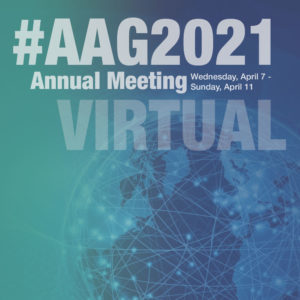 We’re getting closer to the
We’re getting closer to the 


 Linked in
Linked in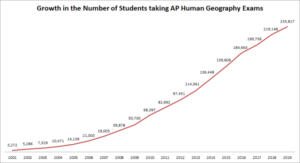
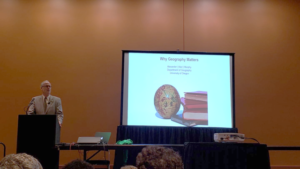
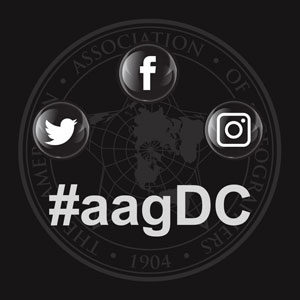 We’re getting closer to the 2019 AAG Annual Meeting! Whether you will be attending the meeting all week, for a few days, or looking to follow the action from afar, there are plenty of ways to get involved using social media. Social media is a great way for seasoned conference goers and newcomers alike to network, report on new research, engage in lively debate with those inside and outside of the discipline, and find out what’s going on during the largest geography conference in the world! Start planning your #aagDC social media strategy today with these helpful guidelines!
We’re getting closer to the 2019 AAG Annual Meeting! Whether you will be attending the meeting all week, for a few days, or looking to follow the action from afar, there are plenty of ways to get involved using social media. Social media is a great way for seasoned conference goers and newcomers alike to network, report on new research, engage in lively debate with those inside and outside of the discipline, and find out what’s going on during the largest geography conference in the world! Start planning your #aagDC social media strategy today with these helpful guidelines!



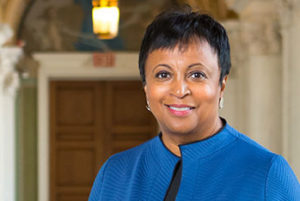 The American Association of Geographers invites attendees of the 2019 AAG Annual Meeting in Washington, D.C., to join in celebration of Carla Hayden at the AAG Atlas Award Ceremony. Carla Hayden, 14th Librarian of Congress, will deliver a keynote address at noon on Friday, April 5, after being presented with the 2019 AAG Atlas Award, the association’s highest honor.
The American Association of Geographers invites attendees of the 2019 AAG Annual Meeting in Washington, D.C., to join in celebration of Carla Hayden at the AAG Atlas Award Ceremony. Carla Hayden, 14th Librarian of Congress, will deliver a keynote address at noon on Friday, April 5, after being presented with the 2019 AAG Atlas Award, the association’s highest honor.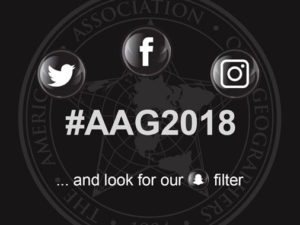 We’re getting closer to the 2018 AAG Annual Meeting! Whether you will be attending the meeting all week, for a few days, or looking to follow the action from afar, there are plenty of ways to get involved using social media. Social media is a great way for seasoned conference goers and newcomers alike to network, report on new research, engage in lively debate with those inside and outside of the discipline, and find out what’s going on during the largest geography conference in the world! Start planning your #AAG2018 social media strategy today with these helpful guidelines!
We’re getting closer to the 2018 AAG Annual Meeting! Whether you will be attending the meeting all week, for a few days, or looking to follow the action from afar, there are plenty of ways to get involved using social media. Social media is a great way for seasoned conference goers and newcomers alike to network, report on new research, engage in lively debate with those inside and outside of the discipline, and find out what’s going on during the largest geography conference in the world! Start planning your #AAG2018 social media strategy today with these helpful guidelines!


 Snapchat
Snapchat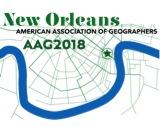
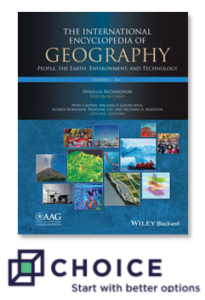 The AAG-Wiley
The AAG-Wiley 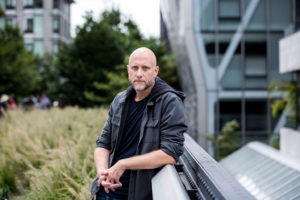 Geographer and artist
Geographer and artist